DIY Weather Station
 After a few snippets Arduino code for the ESP8266, I now have a concrete project that I want to solve with the ESP8266. I like to build a weather station that not simply measures and displays like a traditional weather station, but more like a DIY Netatmo also providing the data via a mobile website.
After a few snippets Arduino code for the ESP8266, I now have a concrete project that I want to solve with the ESP8266. I like to build a weather station that not simply measures and displays like a traditional weather station, but more like a DIY Netatmo also providing the data via a mobile website.
In order to achieve the readings and a few other parameters I sent them by MQTT to a broker, where they are collected by a small program to display the current values on a Web page and to visualize the time series.
I will distribute some of the stations in the house in order to monitor the equipment room, bedrooms, etc. to be always informed about the important values. The main station will be equipped with DHT22 and BMP280 sensors, the rest only with the DHT22 or other sensors for humidity and temperature. The whole has to be at various points running on battery power, as no mains are immediately everywhere. To operate the station for a while without having to constantly recharge the accumulators, I incorporated my results for a snippet about the deep sleep function of the ESP8266. The battery voltage is sent together with each measurement to the broker and generates from there an event via the Maker Channel of IFTTT when a threshold is reached. As battery a LiIon cell of Type 18650 is used, enabling an operating time of more than a week at 4 measurements per hour. So the station is on for just about 30 seconds (I added a break in the code so that the ESP8266 is long enough for a firmware update) with a cycle length of 15 minutes.
To get a high WAF for the device, (WAF is an acronym designed by the German computer magazine „ct“. It can be translated by Women Acceptance Factor) a housing was designed on tinkercad.com, it consists of three parts. The first part considers the whole electronics and the battery. The second part represents the bottom plate where the battery sits and also closes the battery bay. It is a bit larger in diameter, so that the cylinder which closes the whole has a stop when it is slipped over the inner structure.
Visualization of MQTT data
Material & Links
Code & 3D-Dateien
Attribution-NonCommercial-ShareAlike 3.0 Unported
Firmware licensed under Apache License 2.0
Apache License 2.0











